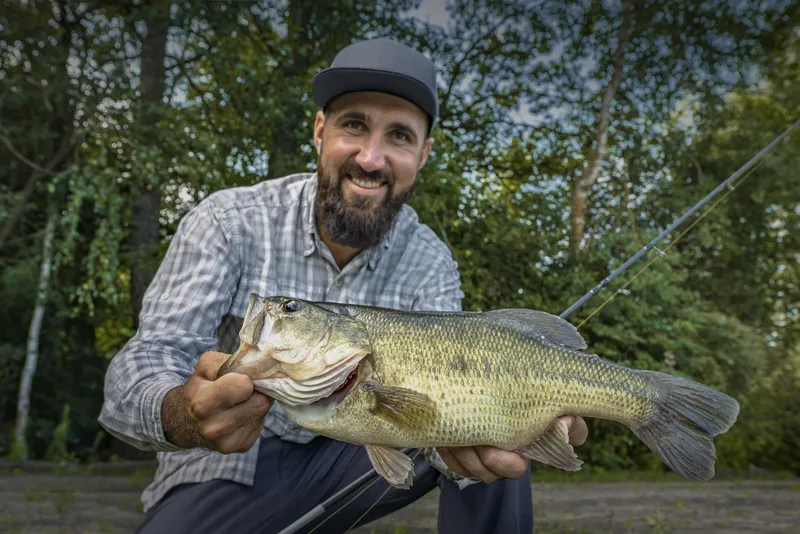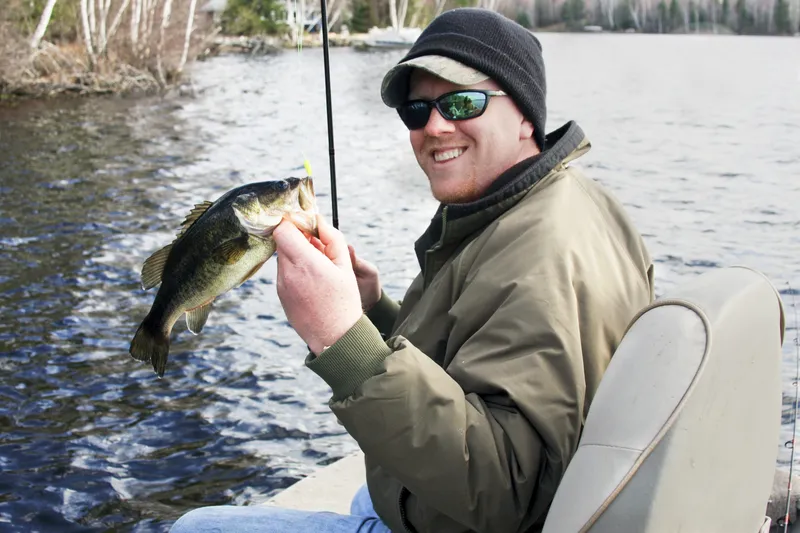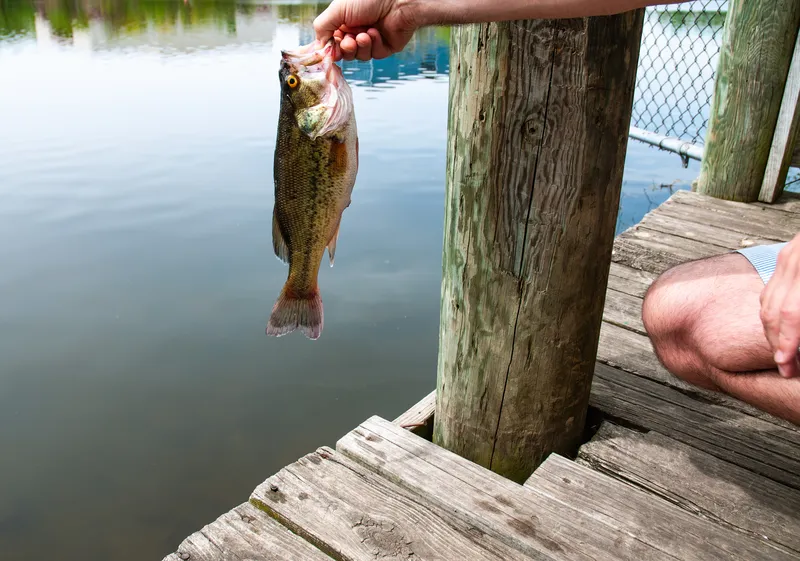
The Case For Freshwater Bass As A Delicious Choice
Freshwater bass is often overlooked as a food source, but it truly deserves a spot on your dinner table. As someone who has experienced the joy of eating freshly caught and perfectly cooked freshwater bass, I can attest to its delicious taste and versatility in the kitchen. One of the best things about freshwater bass is that it can be found in many bodies of water across the United States.
Whether you live near a lake, river, or stream, chances are you can find some freshwater bass lurking beneath the surface. And when you do catch one, you’re in for a treat.
But why should you choose freshwater bass over other types of fish? For starters, it’s a game fish that puts up a fight when caught, making it all the more rewarding to eat.
Additionally, its firm texture and mild flavor make it an ideal canvas for experimenting with different cooking methods and flavor combinations. So if you’re ready to expand your culinary horizons and try something new, give freshwater bass a chance – I promise you won’t regret it.
The Joy Of Catching Freshwater Bass
Catching your own food is one of life’s simple pleasures, and freshwater bass provides an excellent opportunity to do just that. Whether you’re an experienced angler or just starting out, there’s nothing quite like reeling in a big bass from the water. So where can you find these elusive fish?
While they can be found in many bodies of water across the United States, some popular spots include Lake Erie in Ohio; Lake Okeechobee in Florida; and Lake Texoma on the border of Texas and Oklahoma. Of course, there are also plenty of smaller lakes and rivers where freshwater bass can be found – it just takes a bit of research and exploration to find them.
Once you’ve found your spot, it’s time to start fishing. There are a variety of techniques for catching freshwater bass, including using lures such as plastic worms or crankbaits; live bait such as minnows or nightcrawlers; and even fly fishing.
The key is to experiment and find what works best for you in the particular body of water you’re fishing in. And when you finally do catch that big bass, the satisfaction of knowing that you caught your own dinner is unbeatable.
Freshwater bass is a delicious choice for those looking to expand their culinary horizons and experience the joy of catching their own food. Stay tuned for the next section where we’ll dive into how to prepare your catch for cooking.
Catching Freshwater Bass

Where To Find Them: Lakes, Rivers, And Streams Across The United States
Freshwater bass is a game fish that can be found in many bodies of water across the United States. Whether you’re in the Midwest fishing for largemouth bass or in the South targeting spotted bass, there’s always a body of water within driving distance that holds these delicious fish. In my opinion, there’s nothing quite like catching your own dinner from a nearby lake or river.
However, it’s important to note that not all bodies of water are created equal. Some lakes and rivers have higher populations of freshwater bass than others.
It’s important to do your research before heading out to ensure that you’re fishing in an area with a good population of fish. Don’t waste your time on a body of water that doesn’t hold many fish – trust me, I’ve learned this lesson the hard way.
Best Time To Catch Them: Early Morning Or Late Afternoon When They Are Most Active
Freshwater bass are most active during feeding times – typically early morning and late afternoon. This is when they’ll be most likely to bite on your bait or lure.
Of course, this can vary depending on the season and weather conditions. In my experience, I’ve found that early mornings are some of the best times to catch freshwater bass.
There’s something peaceful about being out on a lake as the sun rises and casting your line out into the calm waters while listening to nature wake up around you. Plus, if you’re lucky enough to catch fish during this time period, you’ll have freshly caught dinner ready for later in the day.
Techniques For Catching Them: Using Lures Or Live Bait Such As Worms Or Minnows
There are many techniques for catching freshwater bass – some swear by using lures, while others prefer live bait like worms or minnows. Personally, I’m a fan of using lures as they allow for more control over how the bait is presented to the fish. When it comes to choosing the right lure, it’s important to pick one that matches the color and size of what the fish are feeding on in that particular body of water.
No products found.
This may require some trial and error. Additionally, I’ve found that fishing near drop-offs or underwater structures such as rocks or logs can increase your chances of catching freshwater bass.
Overall, catching freshwater bass can be a fun and rewarding experience. But remember – always follow local fishing regulations and practice catch-and-release when necessary to ensure that these fish populations remain sustainable for years to come.
Preparing Freshwater Bass For Cooking
Cleaning And Gutting The Fish
One of the most important steps in preparing freshwater bass for cooking is cleaning and gutting the fish. This can be a messy and unpleasant process, but it’s essential to ensure that your fish is safe to eat and free from any unwanted odor or flavor.
The first step is to rinse the fish in cold water to remove any dirt or debris. Then, using a sharp knife, make an incision along the belly of the fish from its head to its anus.
Reach in and remove all of the organs, including the liver, stomach, and intestines. Be careful not to puncture any organs during this process as this can cause contamination.
Once you have removed all of the organs, rinse out the cavity with cold water until it runs clear. You can then pat dry with paper towels or a clean cloth before proceeding with scaling and deboning.
Scaling The Fish
The next step in preparing freshwater bass for cooking is scaling. Scaling removes all of the tiny scales on a fish’s skin that can affect its texture when cooked.
Scales are also undesirable because they are tough and difficult to chew. To scale your fish, hold it firmly by its tail with one hand while scraping off scales with a scaler or spoon with your other hand.
Start from tail-to-head motion as it will not damage their delicate flesh-wise fibers beneath their scales. Beware; scales tend to fly around during scaling; therefore you should contain them on a newspaper or within some other specified tray for convenience.
Removing Bones
Removing bones from freshwater bass can take time but is worth it when enjoying boneless fillets that melt in your mouth without choking hazards lurking within them! After cleaning up your fish let’s move on towards removing its bones. Using tweezers or pliers, carefully remove any remaining bones from the fish.
If you are planning to cook the fish whole, be mindful of any pin bones on the sides of the fish. Preparing freshwater bass for cooking is a bit of work but not that difficult if you know what to do.
Cleaning, scaling and deboning are essential steps to ensure your fish is safe to eat and enjoyable to cook. Once done with these steps, you can move forward with grilling or baking methods depending on your preference.
Cooking Freshwater Bass

Grilling: A Smoky Delight
When it comes to cooking freshwater bass, grilling is an excellent choice. This method of cooking imparts a smoky flavor that perfectly complements the mild, sweet taste of the fish.
To get started, season your fish with herbs and spices of your choosing. I like to use a mixture of garlic powder, smoked paprika, and a touch of cayenne for a little kick.
Then grill over an open flame until the skin is crispy and the flesh is cooked through. One key to successful grilling is to make sure you have a clean grill grate.
Brush it with oil before placing the fish on top so that it doesn’t stick. Additionally, be sure not to flip your fish too soon – let it cook on one side until it’s nicely browned and easily releases from the grill grate.
Don’t be afraid to experiment with different seasonings and flavors! Freshwater bass is versatile enough to pair well with everything from lemon juice to fresh herbs.
Pan-Frying: A Crispy Treat
If you’re looking for a crispy treat, pan-frying freshwater bass might be just what you need! Start by coating your fillets in flour or breadcrumbs seasoned with salt and pepper.
Then fry them in hot oil until they’re golden brown on both sides. The result?
Crunchy goodness on the outside and tender flaky goodness on the inside. One thing I particularly love about pan-frying freshwater bass is how adaptable it can be based on what you have in your pantry.
No products found.
Use panko breadcrumbs for extra crunch or add some grated Parmesan cheese for more flavor – there are endless possibilities! Don’t forget to keep an eye on your oil temperature as well; if it’s too hot, your fish will burn quickly; if it’s not hot enough, your fish won’t get crispy.
Baking: A Fancy Twist
For a fancy twist on freshwater bass, try baking it in the oven! Start by stuffing the cavity with herbs and lemon slices to add extra flavor.
Then bake at 350°F until the fish is cooked through and flaky. This method of cooking is particularly good for larger whole fish rather than fillets. After this article, check out The Best Catfish Rig for Bank Fishing
The great thing about baking freshwater bass is that you have a lot of flexibility in terms of how you season and serve it. You can go classic with lemon wedges and parsley, or experiment with different herbs like thyme or rosemary.
You can also add sliced vegetables to the pan for an even more complete meal. The possibilities are endless!
Frequently Asked Questions
There are various methods to catch freshwater bass such as using lures, live baits or artificial baits. Understanding the behavior of bass and the environment can increase your chances of a successful catch.
Largemouth bass can be cooked using various methods such as grilling, frying or baking. Before cooking, it is important to clean and season the fish.
The effectiveness of bait can vary depending on various factors such as location, season and water temperature. Some popular baits for catching largemouth bass include worms, minnows and jigs.
The first step is to clean and gut the fish, then season it to taste. There are various methods for cooking bass including grilling, frying, baking or smoking.
Some tips for catching largemouth bass in Red Dead Redemption 2 include using the right lure or bait for the location and time of day, paying attention to the tension on the fishing line and reeling in at the right time.
The age of a bass can vary depending on various factors such as location and environment, but a 10 lb bass is generally estimated to be around 9-10 years old.